YOUR CART
- No products in the cart.
Subtotal:
$0.00

The story of the UK’s ‘Windrush Generation’ started with hope but ultimately led to injustices that are still being experienced today. It describes individuals and families who came to the UK between 1948 and 1971 from Caribbean countries and refers to the ship MV Empire Windrush which arrived at Tilbury Docks, Essex, on 22 June 1948. There were 492 passengers on that ship, and it’s estimated nearly half a million others have followed them.
Textile artist Sabine Kaner is a member of that Windrush Generation, and she uses her art to sift through her own experiences, as well as raise awareness of both the beauty and pain that rests within that diaspora. Sabine is in love with colour and a master at mixing and manipulating thrifted textiles (including threads) into gorgeous tapestry-like works.
Sabine’s story is especially timely in light of immigration challenges being experienced across the globe. (If you would like to learn more about the Windrush Generation, Sabine recommends the WindrushFoundation.com).
Sabine: I grew up in London during the 1960s. Both my parents were immigrants. My mother came from Germany, and my father from Jamaica. Mixed marriages were frowned upon at that time, and there was a lot of racism and poverty. We lived in poor housing as one family sharing one room with inadequate facilities.
Most immigrants were desperate to better themselves. My parents both worked long hours, often having more than one job, so I saw very little of them. As a result, we had to grow up quickly and become independent. I also spent a lot of time reading, drawing and learning how to sew. These were all quiet activities that suited the environment in which we lived.
I struggled as a child to integrate into three cultures and was bullied a lot at school. My parents told me not to tell people my ethnicity. But that created a lot of confusion and identity issues. I eventually found myself fitting in with other immigrants of various nationalities, because we all shared similar experiences of prejudice, rejection and poverty.
The immigrant experience has had a profound effect on me and my art. It underpins all the work I create.
I was very fortunate to have an art teacher who took an interest in me and encouraged me to apply to art school. I was accepted to study an art foundation at Central Saint Martins in London, and I was the first person to go on to higher education in my family.
Saint Martins gave me many new experiences and opportunities. We visited lots of galleries. One exhibition called ‘Outsider Art’ at London’s Hayward Gallery completely changed my way of thinking about art. It taught me the power art could have in documenting an artist’s life. And it was a way to explore identity, emotions and experiences whilst avoiding traditional art materials, either by choice or necessity.
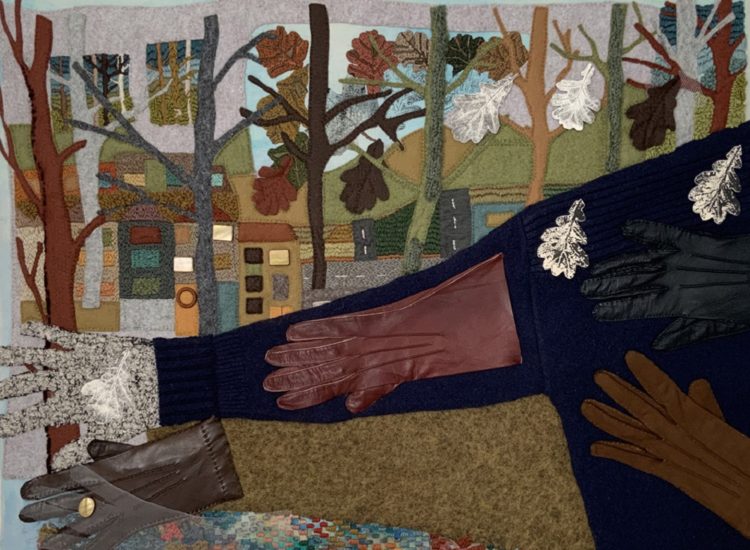
After my foundation, I went to Manchester to study fine art printmaking. It was there I truly fell in love with textiles. I used to visit the textile department and gaze at the wonderful stitching and creations.
I started to incorporate fabric into my screen prints, but unfortunately in those days, it created a lot of disapproval. Subjects were kept very pure and mixing of materials was not encouraged.
When I first started creating textile pieces, I mostly used bits of fabrics and materials that had been donated to me or I had lying around. I had a lot of cotton pillowcases and sheets my mother and grandmother had given me which I used as canvases to sew on. And I cut up bits from discarded and worn out clothes and used whatever threads I already had.
My early pieces were very intense and experimental.
My present process still finds me reusing materials and recycling as much as possible, but I now buy natural unbleached calico on which to sew. I also use donated clothing from family and friends. I buy felt locally and visit charity chops to find discarded crochet and woollen pieces. My mother also left me a large array of embroidery threads which I have incorporated into my work over time.
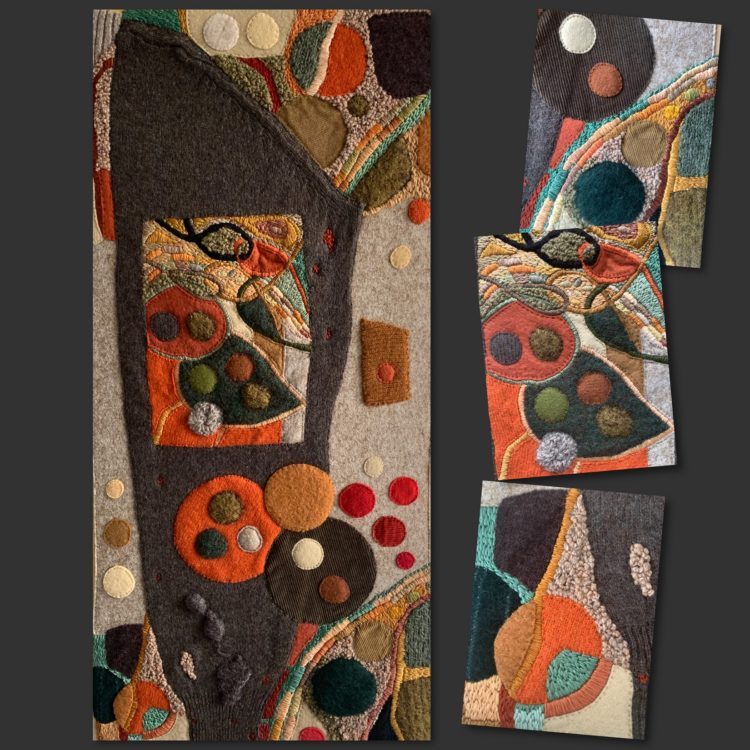
I use printing and paint as the underlying base of my work which I then gradually layer with fabrics and hand embroidery. I use colour intuitively and am aware that it is a powerful tool with the ability to communicate subliminal messages.
I try to create a sense of balance in my compositions with both my colours and shapes.
I use different colours such as a black background to bring other colours forward, so they stand out. Using black creates a dramatic backdrop. It’s a colour that conceals and doesn’t illuminate.
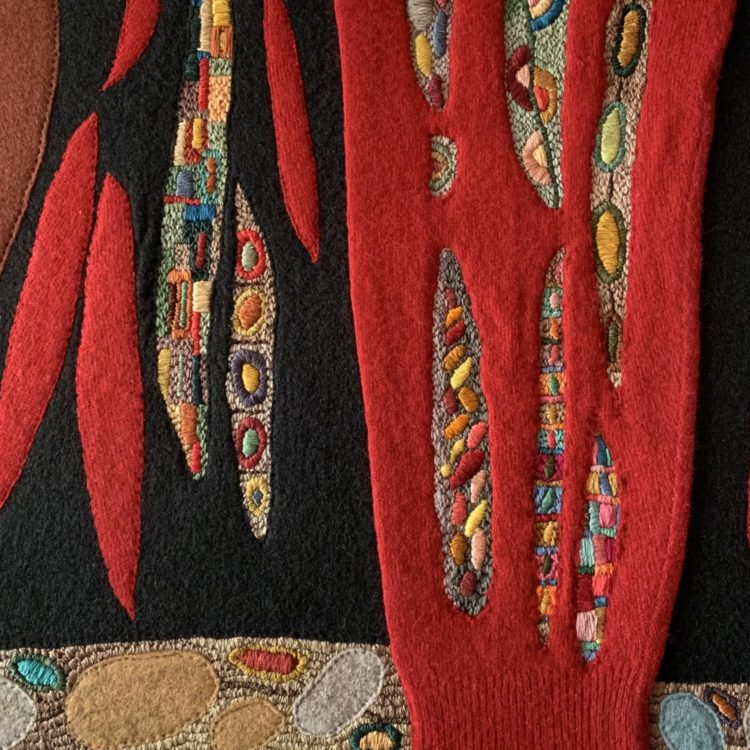
In Decorating the Cuts, I am talking about the difficult topic of mental health distress. I use red to emphasise ‘urgency’. The red is brought forward by placing it on a black background. In Colour of the Nations, I used brown which represents home and family to me. It is the colour of our roots and our history which I combined with the colours of the Jamaican flag.
I also use certain images to help convey messages. For example, hands are symbolic of expression. They can be as expressive as faces with their gestures. And they can give the viewer insight into the story behind a piece.
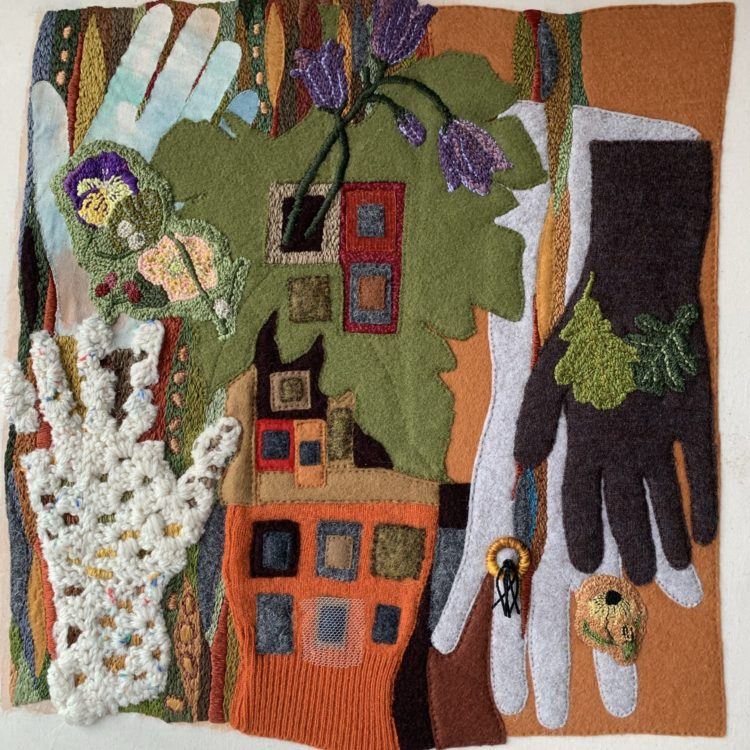
I have always worked with my hands as a maker and hand stitcher, so that is also an underlying narrative. In the Windrush piece, I used hands in different colours to represent my hybrid heritage and identity, which I linked together with red thread.
Sleeves are another frequent icon in my work, adhering to the saying ‘wearing your heart on your sleeve.’
The saying comes from William Shakespeare’s Othello which made a very deep impression on me when I first read it in school. I now use it as a way to express my experience as an official caregiver for my daughter for the past 25 years.
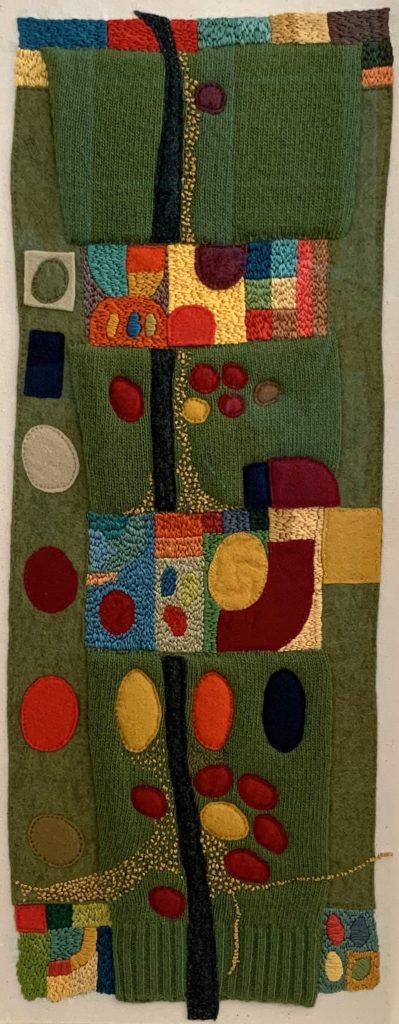
Emotions are always bubbling beneath the surface for which I have no words. Using sleeves is a symbolic way to release some of those feelings. I have created at least half a dozen compositions using sleeves, each expressing different aspects of my complex life journey.
Starting a piece of work requires a lot of organising of ideas. As there are so many interrelated threads (metaphorically speaking), I must tease out which one is the strongest. The advantages and disadvantages of my materials also often dictate some of the design.
I keep a large piece of plain paper on my desk on which I jot down ideas and small sketches. I also have a larger sketchbook I use to draw and experiment with colour. My drawings tend to be loose ideas and don’t usually just sit on one page. I have a separate book where I keep experimental stitches, print experiments and mark making on fabrics.
Every piece I create feels like a journey from the past to the present.
I find myself unpicking memories as I go along, working them through in my mind and then translating them into my compositions through the materials and the act of making. Political, social, economic and cultural identity are all part of the symbolic stories that present themselves in my compositions.
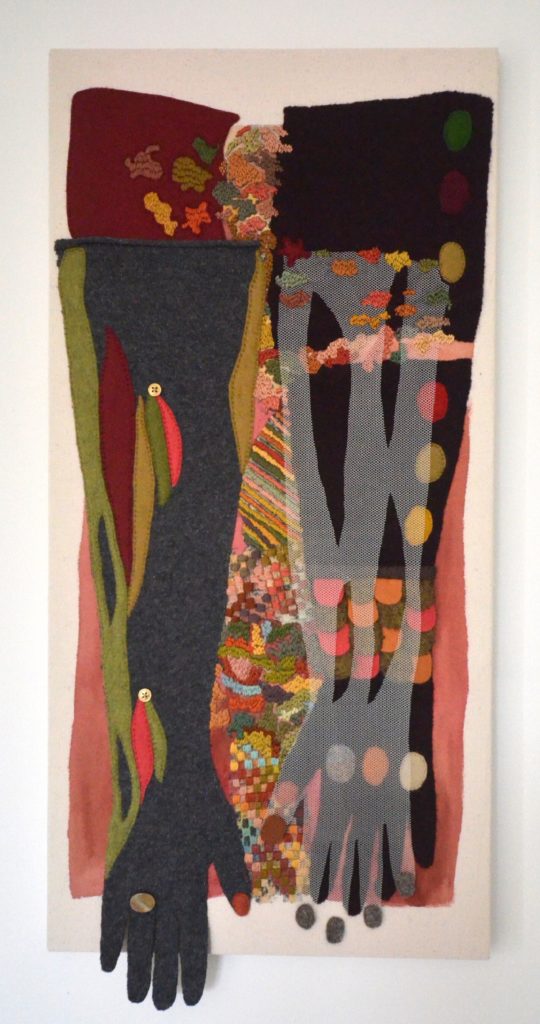
My work has also been influenced by many health challenges in my family, including my own, stemming from genetic disorders. I spent endless hours in treatment centres and hospitals with my disabled daughter. Textiles were portable and lent themselves to quiet environments, so I was able to explore the possibilities of fabric, textures and develop the art of hand stitching.
I work in a mixed-media way creating abstract images that are juxtaposed with contrasting patterns. I layer different processes and techniques either on top of each other or side by side. I then try to connect the separate materials with hand embroidery and stitch.
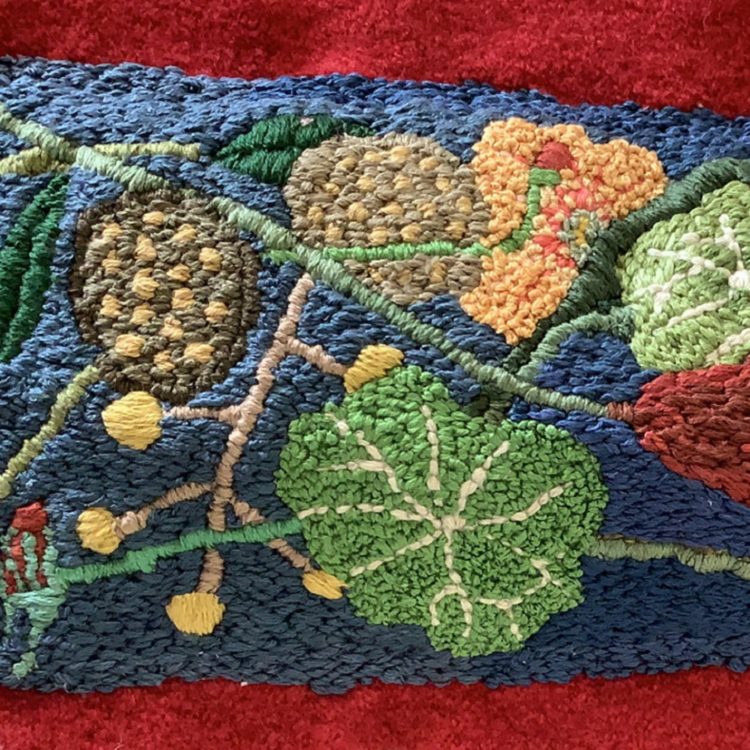
My embroidery mostly uses simple stitches which knit together to form a tapestry of colour. I save every piece of fabric – even tiny pieces – and have a big bag of scraps which I reuse. I also collect buttons, buckles and all the other bits attached to clothing.
When I print on fabric, I try to organise and make multiple prints at one time. I don’t always know how I will incorporate them into my work, but I usually find the textures I create inspire new ideas. My experience of printmaking, especially screen printing, has enabled me to understand how to overlay and use blocks of colour.
I have learnt so many different ways of using fabrics, paper, stitch and print – exploring their different qualities and how to combine them with stitching. I have also experimented with lots of combinations of colour and would like to continue to develop that.
I mostly use thrifted garments because I enjoy making use of the accidental marks, holes and shrinking that occurred over the life of those garments. They always provide more opportunities for embroidery stitches.
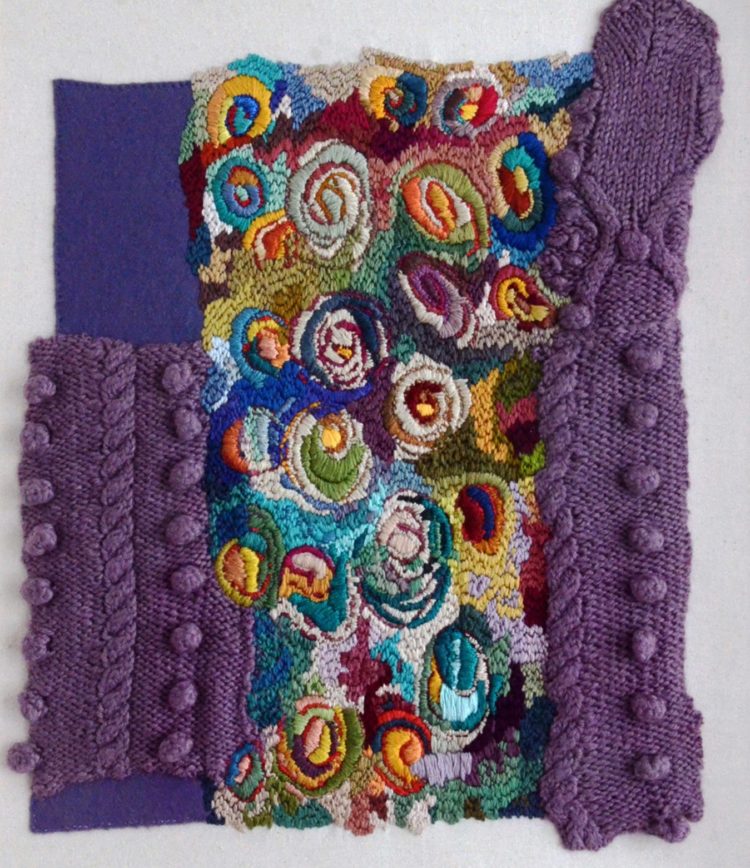
I have particularly fond memories of a piece I created called Blended Stitches that used a favourite hand-knitted jumper. Both my daughter and I wore that jumper until it started to fall apart. She wore it when she was very unwell and found it comforting, as it was big and baggy and very warm.
The piece is flanked by pieces of the jumper on both sides with a panel of embroidery stitches in the middle. I wanted the middle to be like an expressive painting. I find the piece joyous and comforting. And it’s a metaphor for warmth and security and for those who stood by me through many difficult years. I am very grateful.
Sabine Kaner is a member of the artist group @Outsidein where she was selected ‘Artist of the Month.’ She has also exhibited with @SEAS Brighton to celebrate the Windrush Generation’s contributions to the UK and @wellspace in London to coincide with Mental Health Awareness Day. Solo exhibitions were held at Stapleford Granary and 78 Derngate, and open studios were held at Selectarts.
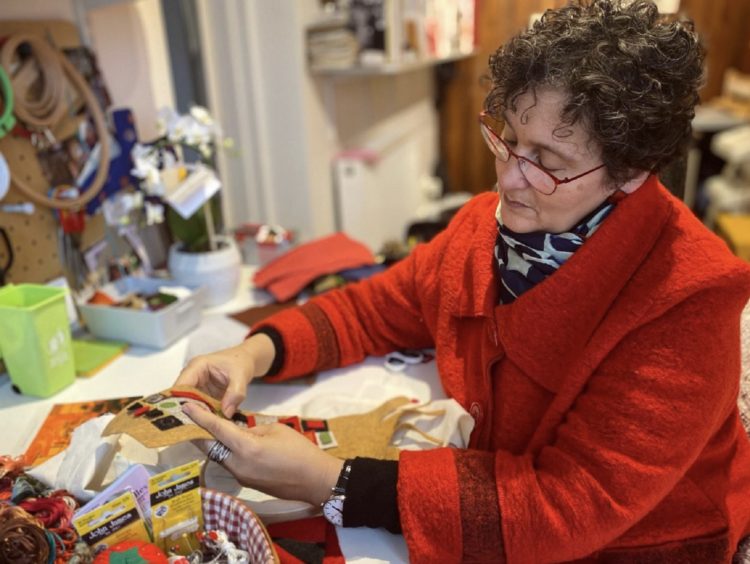
Website: sabinekaner.com
Facebook: Sabine Kaner
Instagram: @sabinemake
If you’re interested in other artists whose culture and family history inform their textile art, check out Izziyana Suhaimi and Emma Shankland’s work.